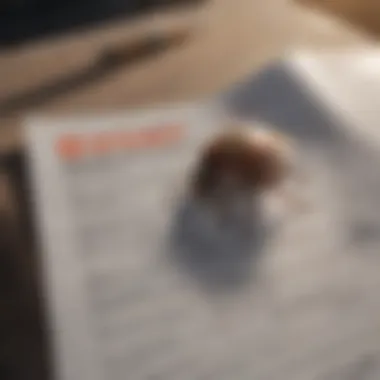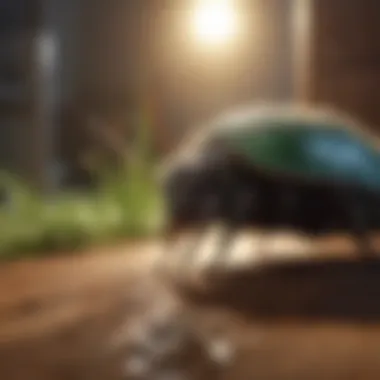Mastering Total Home Pest Control: A Complete Guide


Preventive Pest Control Strategies
When it comes to maintaining a pest-free home environment, implementing preventive pest control strategies is paramount. First and foremost, safeguarding the house exterior is crucial. Seal any cracks or crevices that may serve as entry points for pests, and ensure to clear out debris from the surrounding areas. Proactively preventing pests from entering your home sets a solid foundation for effective pest control.
Yard maintenance plays a significant role in deterring pests. Establishing essential yard care routines such as mowing the lawn regularly and managing vegetation can help keep the yard pest-free. It's essential to understand the impact greenery can have on pest presence and actively work towards maintaining a well-tended yard.
Indoor cleanliness is equally vital in pest prevention. Expert cleaning tips and techniques should be employed to maintain a pest-resistant indoor environment. Regular cleaning practices not only promote hygiene but also eliminate potential hiding spots for pests.
Efficient garbage disposal methods are non-negotiable. Properly disposing of waste not only removes attractants for pests but also helps in deterring them from lingering around the vicinity. Emphasizing the importance of garbage disposal, both indoors and outdoors, can significantly reduce pest infestation risks. Innovative ways to safeguard your home, such as utilizing natural repellents or installing pest barriers, should also be explored for comprehensive pest control.
Understanding Common Household Pests
Household pests can be a significant nuisance and threat to your home environment. In this article, we delve into the crucial topic of understanding common household pests and why it is essential for effective pest control measures. By identifying the types of pests prevalent in homes, homeowners can take proactive steps to prevent infestations and protect their living spaces. Understanding common household pests not only helps in early detection but also enables individuals to choose the most suitable control methods tailored to specific pests. This knowledge empowers homeowners to create a resilient barrier against pest invasions, ensuring a safe and healthy living environment.
Identifying Pest Infestations
Signs of Pest Presence
Distinguishing signs of pest presence is vital in early detection and mitigation of infestations. Common indicators such as droppings, gnaw marks, and peculiar odors signify a potential pest problem. These signs serve as warnings for homeowners to address the issue promptly before it escalates. Understanding the signs of pest presence equips individuals with the knowledge to differentiate between various pest species and implement targeted control measures efficiently. By recognizing these cues, homeowners can prevent widespread infestations and safeguard their homes effectively.
Common Pest Species
Exploring the characteristics of common pest species is imperative in understanding their behavior and habits. Each pest species poses unique challenges and risks to households, making it essential for homeowners to identify them accurately. By familiarizing themselves with the traits and preferences of common pests like rodents, insects, and birds, individuals can devise tailored strategies for pest prevention and control. Knowing the specific pest species enables homeowners to choose appropriate eradication methods that are effective and sustainable in the long run.
Risk Factors for Infestation
Understanding the risk factors that contribute to pest infestations is key to developing preventive measures. Factors such as poor sanitation, localized climate conditions, and nearby food sources can attract pests to homes. By recognizing these risk factors, homeowners can proactively mitigate conducive environments that harbor pests. Addressing these vulnerabilities through proper waste management, structural maintenance, and landscape modifications significantly reduces the likelihood of infestations, ensuring a pest-free living environment for residents.
Effects of Pest Infestations
Health Risks
Pest infestations pose serious health risks to occupants, including allergic reactions, respiratory issues, and the spread of diseases. Understanding the health hazards associated with pests underscores the importance of prompt eradication and preventive measures. By addressing pest infestations promptly, homeowners can protect their health and well-being from potential harm, fostering a safe and hygienic living environment.


Property Damage
Pests can cause extensive damage to property structures, furniture, and belongings through their gnawing, nesting, and feeding activities. The impact of property damage due to pests can be financially burdensome and emotionally distressing for homeowners. Recognizing the destructive potential of pests empowers individuals to implement protective measures and preventive strategies to safeguard their investments and maintain the structural integrity of their homes.
Psychological Impact
The presence of pests in a home can have a profound psychological impact on residents, leading to stress, anxiety, and discomfort. The constant threat of infestations can disrupt the peace of mind and overall well-being of individuals, affecting their quality of life significantly. Understanding the psychological implications of pest infestations highlights the importance of effective pest control practices in preserving not just the physical environment but also the mental health and emotional stability of homeowners.
Preventative Measures
In the realm of total home pest control, understanding the significance of preventative measures is paramount. These measures act as the first line of defense against pesky invaders, aiming to fortify your living space against potential infestations. By implementing proactive strategies, homeowners can significantly reduce the likelihood of pests taking refuge in their homes. Preventative measures encompass a range of practices, from routine maintenance to natural repellents, creating a comprehensive shield against unwanted intruders.
Home Maintenance Practices
Sealing Entry Points
Delving into the specifics of sealing entry points reveals a critical aspect of pest control. By meticulously identifying and sealing off potential entryways such as gaps in walls, windows, and doors, homeowners can effectively block the path for pests seeking shelter indoors. The meticulous sealing of entry points not only prevents pests from infiltrating your home but also aids in maintaining a secure and pest-free environment. The key characteristic of sealing entry points lies in its ability to create a barrier that deters pests from entering, making it a popular and essential choice for combating infestations. The unique feature of sealing entry points is its preventive nature which addresses the root cause of pest intrusion, offering long-term protection against unwanted guests.
Proper Waste Management
Proper waste management plays a pivotal role in the comprehensive approach to pest control. By ensuring timely disposal of garbage and maintaining clean waste storage areas, homeowners eliminate attractants that lure pests into their dwellings. The key characteristic of proper waste management is its ability to remove potential food sources, thereby depriving pests of sustenance and compelling them to seek nourishment elsewhere. This practice is not only beneficial in deterring pests but also enhances overall sanitation levels within the home, promoting a healthy living environment. However, a potential disadvantage of improper waste management lies in the risk of attracting pests due to unattended garbage or food waste, emphasizing the importance of this practice in total home pest control.
Regular Cleaning Routines
The implementation of regular cleaning routines is a cornerstone of effective pest management within households. By engaging in consistent cleaning practices, homeowners can reduce the presence of crumbs, spills, and clutter that often serve as magnets for pests. This method not only eradicates potential food sources but also minimizes hiding spots where pests can thrive unnoticed. The key characteristic of regular cleaning routines lies in its ability to maintain hygiene standards that deter pests from infesting living spaces, making it a popular choice for ensuring a pest-free environment. While the advantage of regular cleaning routines is evident in its ability to promote cleanliness and pest prevention, a potential disadvantage may involve the time and effort required to upkeep such practices. Nevertheless, the benefits of consistent cleaning routines far outweigh the drawbacks, contributing significantly to the overall success of total home pest control.
Natural Repellents and Deterrents
Exploring the realm of natural repellents and deterrents unveils a sustainable approach to pest control that resonates with eco-conscious homeowners. By harnessing the power of nature's own defenses, individuals can ward off pests without relying on harmful chemicals or toxic substances. This section delves into the benefits of incorporating natural solutions into pest control strategies, highlighting the efficacy and eco-friendly nature of these repellents.
Essential Oils
Essential oils emerge as a versatile and potent weapon in the battle against household pests. Their natural properties not only repel insects but also emit pleasant aromas, enhancing the ambiance of living spaces. Essential oils serve as a beneficial choice for homeowners seeking non-toxic alternatives to traditional pesticides, promoting a safe and chemical-free pest control method. The unique feature of essential oils lies in their dual functionality of repelling pests while leaving behind a refreshing scent, making them an attractive option for individuals prioritizing both efficacy and aesthetics in pest management.


Plants with Pest-Repelling Properties
Plants harboring pest-repelling properties offer a botanical shield against unwelcome intruders. By strategically placing these plant species around the home, homeowners can naturally deter pests while adding a touch of greenery to their surroundings. The key characteristic of these plants lies in their ability to emit odors or substances that repel insects, creating a natural barrier against infestations. Homeowners looking to enhance their indoor environment with greenery will find plants with pest-repelling properties to be a popular and beneficial choice, as they not only beautify living spaces but also act as eco-friendly pest control agents. However, a potential disadvantage may arise if these plants require specific care or conditions to thrive, necessitating research and attention to ensure their effectiveness in pest management.
Eco-Friendly Solutions
Embracing eco-friendly solutions in pest control aligns with the principles of sustainability and environmental consciousness. By opting for natural and biodegradable alternatives, homeowners can combat pests while minimizing the impact on the ecosystem. Eco-friendly solutions offer a beneficial choice for those seeking to protect the environment while safeguarding their homes from infestations. The unique feature of these solutions lies in their ability to deliver effective pest control without harming the environment, making them a conscientious and responsible option for eco-minded individuals. While the advantages of eco-friendly solutions are evident in their harmony with nature and reduced ecological footprint, potential disadvantages may include limited availability or higher costs compared to conventional pest control methods. However, the long-term benefits of supporting eco-friendly practices in pest control far outweigh any short-term drawbacks, fostering a sustainable and eco-conscious approach to total home pest management.
Professional Pest Control Services
In the realm of total home pest control, engaging the services of professional pest control companies plays a vital role in maintaining a pest-free environment. These experts bring a wealth of knowledge and experience to effectively tackle pest infestations. By entrusting the job to professionals, homeowners can benefit from specialized treatments tailored to their specific pest issues, ensuring long-term relief.
Choosing the Right Extermination Company
- Research and Recommendations:
Engaging in thorough research and seeking recommendations for pest control services are crucial steps in selecting the right extermination company. By evaluating the reputation, experience, and customer reviews of different companies, homeowners can make an informed choice. Research helps identify companies with a track record of successful pest control outcomes, ensuring effective solutions tailored to individual needs. Recommendations from trusted sources further validate the credibility and reliability of pest control providers.
- Pest-Specific Expertise:
Pest-specific expertise is a key factor to consider when selecting an extermination company. Companies with in-depth knowledge of common household pests and their behaviors can devise targeted strategies to eliminate pests effectively. Expertise in handling various pest species ensures a comprehensive approach to pest control that addresses specific infestations with precision and efficiency.
- Eco-Friendly Practices:
As environmental consciousness grows, homeowners are increasingly seeking pest control companies that employ eco-friendly practices. Choosing a company that prioritizes environmentally safe pest control methods not only ensures the well-being of inhabitants but also minimizes harm to the ecosystem. Eco-friendly practices utilize non-toxic products and sustainable techniques that effectively manage pests while preserving the environment.
Treatment Options
- Chemical Treatments:
Chemical treatments, while effective in combating pests, come with considerations for safety and environmental impact. These treatments involve the application of pesticides to eliminate pests promptly. Their rapid efficacy and broad spectrum of coverage make them a popular choice for homeowners dealing with severe infestations. However, the potential health risks associated with chemical treatments necessitate proper application and adherence to safety guidelines.
- Heat Remediation:


Heat remediation is a non-chemical pest control method that utilizes high temperatures to exterminate pests. This approach is particularly suitable for eradicating bed bugs and other heat-sensitive pests. By raising the indoor temperature to lethal levels for pests, heat remediation provides a targeted and eco-friendly solution. Its non-toxic nature makes it safe for both occupants and the environment.
- Integrated Pest Management:
Integrated Pest Management (IPM) is a holistic approach to pest control that combines multiple strategies for long-term prevention and management. IPM integrates various methods such as biological control, habitat modification, and monitoring to address pest issues sustainably. By minimizing reliance on chemical treatments and emphasizing prevention, IPM promotes environmentally conscious pest control practices that prioritize ecosystem health and long-term pest management.
Section 4: Sustainable Pest Control Practices
Environmentally Conscious Approaches
Non-Toxic Pest Control Products
When it comes to non-toxic pest control products, the emphasis is on using formulations that are safe for humans, pets, and the environment. These products rely on natural ingredients or less harmful chemicals to target pests without leaving harmful residues. The key characteristic of non-toxic products is their ability to offer effective pest control without posing health risks to inhabitants or harming beneficial organisms. In this article, non-toxic pest control products are highlighted as a popular choice due to their eco-friendly nature and minimal impact on ecosystems. Their unique feature lies in their gentle yet efficient pest control capabilities. While they may require more frequent application compared to traditional pesticides, their advantages include reduced toxic exposure and environmental contamination.
Biological Pest Control Methods
Utilizing biological pest control methods involves harnessing natural predators, parasites, or pathogens to manage pest populations. By introducing natural enemies of pests, such as predator insects or bacteria, biological control offers a sustainable and targeted approach to pest management. The key characteristic of biological control methods is their ability to establish a balance in the ecosystem by maintaining pest populations at tolerable levels. In this article, biological pest control methods are portrayed as a beneficial choice for their non-toxic nature and specific targeting of pest species. Their unique feature is the natural way in which they reduce pest numbers while avoiding chemical intervention. However, the effectiveness of biological control methods may be influenced by environmental conditions and pest species, which may be considered as disadvantages in certain scenarios.
Habitat Modification
Habitat modification involves altering the environment to make it less hospitable for pests, thus reducing their presence. This can include removing potential food sources, sealing entry points, and creating physical barriers to deter pests. The key characteristic of habitat modification is its emphasis on addressing the root causes of pest infestations by making the environment less conducive to pests. In this article, habitat modification is depicted as a proactive and sustainable choice for pest management. Its unique feature lies in its holistic approach to pest control, targeting the factors that attract pests in the first place. While habitat modification can be highly effective in pest prevention, it may require ongoing maintenance and diligence, which could be considered a potential disadvantage.
Long-Term Pest Management Strategies
While short-term solutions may provide immediate relief from pests, long-term pest management strategies focus on preventing infestations and maintaining a pest-free environment over time. By incorporating education and awareness, regular inspections, and community involvement, homeowners can lay the groundwork for sustained pest control.
Education and Awareness
One of the fundamental aspects of long-term pest management is education and awareness. By informing homeowners about the behavior of common pests, potential infestation risks, and effective prevention methods, education plays a key role in empowering individuals to take proactive measures. The key characteristic of education and awareness is its capacity to instill a sense of responsibility and knowledge among homeowners, enabling them to make informed decisions about pest control. In this article, education and awareness are positioned as essential tools for effective and sustainable pest management. The unique feature of education and awareness is their ability to promote proactive pest control practices and reduce dependence on reactive measures. However, the challenge lies in ensuring that information is accessible, accurate, and actionable for homeowners.
Regular Inspections
Conducting regular inspections of your home and property is vital for early detection of pest issues and monitoring potential entry points for pests. By identifying signs of pest activity promptly, homeowners can implement timely interventions to prevent infestations from taking hold. The key characteristic of regular inspections is their proactive nature, allowing homeowners to stay ahead of pest problems and address issues before they escalate. In this article, regular inspections are emphasized as a beneficial practice for ongoing pest management. Their unique feature lies in the ability to identify pest vulnerabilities and implement targeted solutions. While regular inspections require time and effort, their advantages include early intervention and cost-effective pest control measures.
Community Involvement
Engaging with the community on pest control initiatives fosters collaboration and shared responsibility in maintaining a pest-free environment. By coordinating efforts with neighbors, local organizations, or pest control professionals, homeowners can address pest issues collectively. The key characteristic of community involvement is its capacity to leverage collective knowledge and resources for effective pest management on a broader scale. In this article, community involvement is presented as a valuable strategy for establishing sustainable pest control practices within neighborhoods. Its unique feature lies in the collaborative approach to pest management, promoting a sense of community stewardship and resilience against pest threats. While community involvement can enhance pest control outcomes, challenges may arise in coordinating efforts and sustaining community engagement over time.
By integrating sustainable pest control practices and long-term management strategies, homeowners can create a resilient and pest-free living environment that benefits both people and nature.



